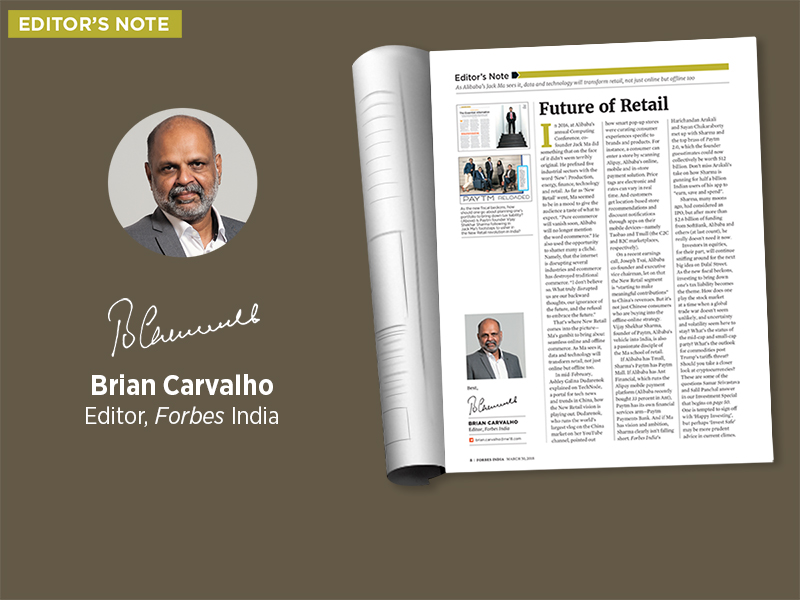
Future of retail
As Alibaba's Jack Ma sees it, data and technology will transform retail, not just online but offline too

In 2016, at Alibaba’s annual Computing Conference, co-founder Jack Ma did something that on the face of it didn’t seem terribly original. He prefixed five industrial sectors with the word ‘New’: Production, energy, finance, technology and retail. As far as ‘New Retail’ went, Ma seemed to be in a mood to give the audience a taste of what to expect. “Pure ecommerce will vanish soon, Alibaba will no longer mention the word ecommerce.” He also used the opportunity to shatter many a cliché. Namely, that the internet is disrupting several industries and ecommerce has destroyed traditional commerce. “I don’t believe so. What truly disrupted us are our backward thoughts, our ignorance of the future, and the refusal to embrace the future.”
That’s where New Retail comes into the picture—Ma’s gambit to bring about seamless online and offline commerce. As Ma sees it, data and technology will transform retail, not just online but offline too.
In mid-February, Ashley Galina Dudarenok explained on TechNode, a portal for tech news and trends in China, how the New Retail vision is playing out. Dudarenok, who runs the world’s largest vlog on the China market on her YouTube channel, pointed out how smart pop-up stores were curating consumer experiences specific to brands and products. For instance, a consumer can enter a store by scanning Alipay, Alibaba’s online, mobile and in-store payment solution. Price tags are electronic and rates can vary in real time. And customers get location-based store recommendations and discount notifications through apps on their mobile devices—namely Taobao and Tmall (the C2C and B2C marketplaces, respectively).
On a recent earnings call, Joseph Tsai, Alibaba co-founder and executive vice chairman, let on that the New Retail segment is “starting to make meaningful contributions” to China’s revenues. But it’s not just Chinese consumers who are buying into the offline-online strategy. Vijay Shekhar Sharma, founder of Paytm , Alibaba’s vehicle into India, is also a passionate disciple of the Ma school of retail.
If Alibaba has Tmall, Sharma’s Paytm has Paytm Mall. If Alibaba has Ant Financial, which runs the Alipay mobile payment platform (Alibaba recently bought 33 percent in Ant), Paytm has its own financial services arm—Paytm Payments Bank. And if Ma has vision and ambition, Sharma clearly isn’t falling short. Forbes India’s Harichandan Arakali and Sayan Chakraborty met up with Sharma and the top brass of Paytm 2.0 , which the founder guesstimates could now collectively be worth $12 billion. Don’t miss Arakali’s take on how Sharma is gunning for half a billion Indian users of his app to “earn, save and spend”.
Sharma, many moons ago, had considered an IPO, but after more than $2.6 billion of funding from SoftBank, Alibaba and others (at last count), he really doesn’t need it now.
Investors in equities, for their part, will continue sniffing around for the next big idea on Dalal Street. As the new fiscal beckons, investing to bring down one’s tax liability becomes the theme. How does one play the stock market at a time when a global trade war doesn’t seem unlikely, and uncertainty and volatility seem here to stay? What’s the status of the mid-cap and small-cap party? What’s the outlook for commodities post Trump’s tariffs threat? Should you take a closer look at cryptocurrencies? These are some of the questions Samar Srivastava and Salil Panchal answer in our Investment Special.
One is tempted to sign off with ‘Happy Investing’, but perhaps ‘Invest Safe’ may be more prudent advice in current climes.
Best,
Brian Carvalho
Editor, Forbes India
Email:Brian.Carvalho@nw18.com
Twitter id:@Brianc_Ed
(This story appears in the 30 March, 2018 issue of Forbes India. To visit our Archives, click here.)















